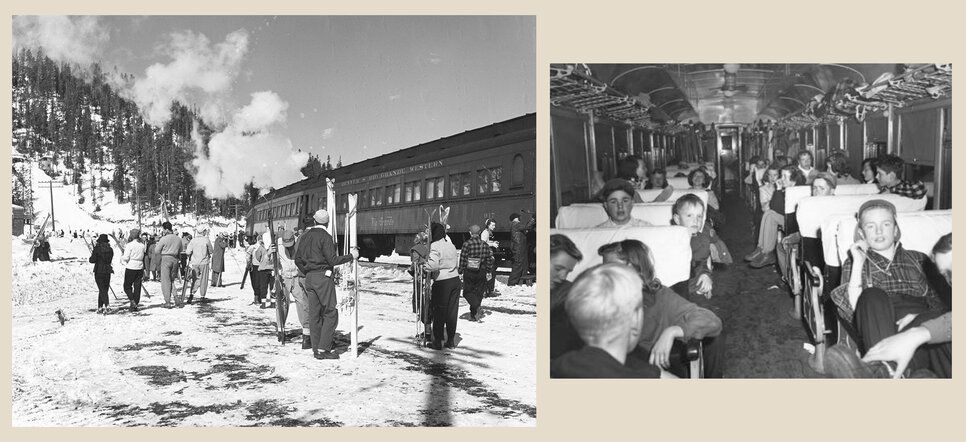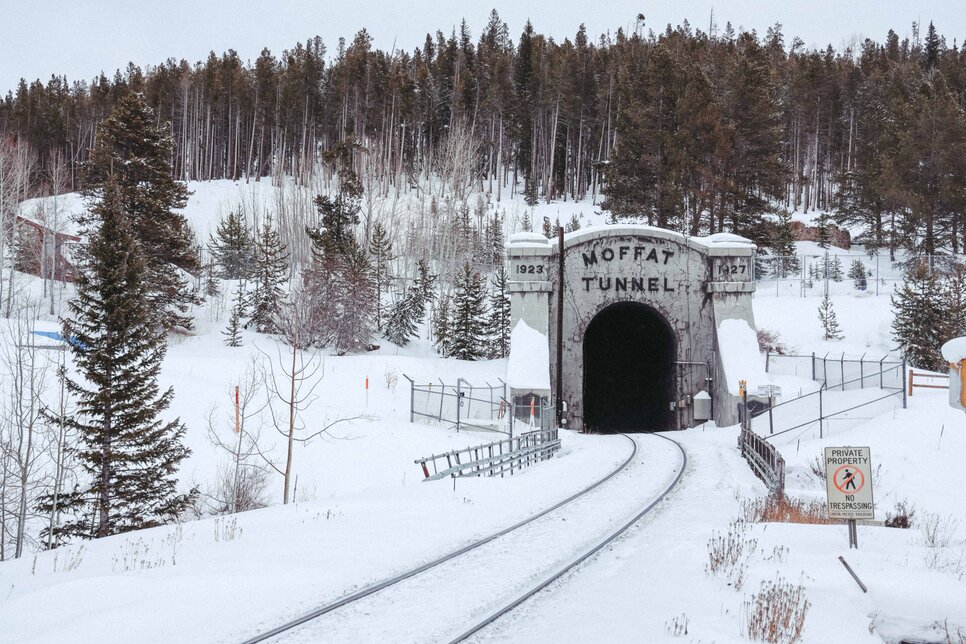All aboard the Winter Park Express

DENVER — Before sunrise on a bitter cold Friday morning at Denver’s Union Station, a group of bundled up passengers eagerly entered the warmth of their Amtrak train.
Some wore street clothes, but many of the people huddled on the platform were decked out in beanies, parkas and snow pants — signs of a promising ski day. That morning, January 12, marked the maiden voyage for the 2024 season of Amtrak’s “Winter Park Express,” a nonstop, two-hour train ride from Denver to the slopes of Winter Park Resort.
As traffic on I-70 worsens and the scale of car pollution becomes clearer — traveling by train results in a much smaller carbon footprint than driving — state leaders are hoping rail travel, including the Winter Park Express, becomes more popular among Coloradans and tourists alike.

On the inaugural 2024 Winter Park Express ride, passengers traveling with their own skis or snowboards handed the equipment to volunteers who placed the gear in the train’s first-level storage unit. The riders then made their way to their seats, many hurrying to the Sightseer Lounge that boasts floor-to-ceiling windows. They didn’t want to miss the sunrise.

The train left Union Station at 7:00 a.m. on the dot. Friends Lakeidra Bronner and Thameka Hall, both visiting from out of state for a “girls’ trip,” were happy they took the train.
“We just felt like it would be more comfortable and relaxing — taking in the views to really get the full experience,” Hall said.
“First of all, it’s beautiful,” she continued, gesturing to the mountains of the Front Range that were finally revealed by the morning sun. “It’s been dark since we got here.”


Tickets are $59 per person for a round trip. The train will run 40 times this year — every Friday, Saturday and Sunday from January 12 to March 31. Amtrak is also offering “bonus Thursdays” on March 14 and 21. The train arrives in Winter Park at 9:00 a.m. and leaves at 4:30 p.m. — more than enough for a full day of skiing.
As the train glided through the western suburbs of Denver, the conductor, Brad Swartzwelter, was overjoyed to tell the passengers over the intercom that they had made the correct decision in taking the train: at the time, parts of I-70 were closed due to “sun glare.”
That was exactly why Emily Spica, who often drives from Fort Collins to Winter Park to snowboard, opted to take the train.
“I was going to drive, and looked at the snow report and winds, and didn’t want to deal with Berthoud Pass,” Spica said. (Two days later, 10 cars were caught in an avalanche on Berthoud Pass.)


The Winter Park Express dates back to 1940, the same year Winter Park Resort opened for skiing (Vail and Breckenridge, by contrast, didn’t offer skiing until the 60s). Initially dubbed the “Ski Train,” the Denver and Rio Grande Western Railroad operated the line. It ran until 2009, when rising costs and the global financial crisis resulted in a cancellation of service.

The "Ski Train" began operations in 1940. Above, skiiers and passengers are shown riding the train during the 1948 season.
Photos: Denver Public Library, "Artistry of Railroads" collection
Amtrak brought the Ski Train back for a one-day-only event in 2015 to celebrate the line’s 75th anniversary. When the 400 tickets sold out within a day, Amtrak promptly added a second trip for the following day.
The Winter Park Express officially returned in 2017 and, COVID-19 cancellations in 2020 and 2021 notwithstanding, has been in service ever since. In 2019, the route set a ridership record, selling more than 19,000 tickets. That number took a dip after the pandemic but by the 2022 season, the train logged 16,000 riders, according to Amtrak's senior public relations manager Marc Magliari.
Things might be looking up for the Winter Park Express this season, however. Magliari said there were 1,800 riders on opening weekend this year. Should Amtrak keep that pace for the remainder of the season, the 2024 season of The Winter Park Express would eclipse 2019's ridership numbers.



Jared Jacobosky said he would definitely take the train in the future. In the Sightseer Lounge, sitting with his friends, Jacobosky was overheard saying the train was “10 times better than driving.”
He drove to Winter Park the previous weekend for a friend’s birthday. “With the snow coming down, it took us about three and a half hours to get from downtown Denver to Winter Park, which is not fun,” he said (the drive, without traffic, is normally about one hour and 20 minutes). “This not only eliminates all of that, but it gives you peace of mind. You know when you’re going to get there and when you’re going to leave and you get the whole day, no matter what.”
Sitting near Jacobosky in the lounge was Colorado Governor Jared Polis.

“[I’m] so glad I didn’t have to navigate Berthoud Pass with this weather,” Polis, a Democrat, said after the train arrived in Winter Park. “It’s 59 bucks, and you know what, there’s more to come. We want to make it more convenient, less expensive, [and] include Steamboat and Rollinsville, Eldora on this route. We’re working on mountain rail to make sure you have a better way to get to the mountain areas — both for tourists to power our economy, and for Denver metro area residents and Colorado residents who want to have fun in the mountains.”
Today, most active trains in Colorado function as attractions, such as the Georgetown Loop or the Durango & Silverton Narrow Gauge Railroad. Intercity passenger rails — most of which went out of service in the 1970s — are limited to two Amtrak options: The California Zephyr travels from Chicago to San Francisco and makes six stops in Colorado, including Denver and Grand Junction. The Southwest Chief, meanwhile, travels from Chicago to Los Angeles with three stops in the southeastern part of Colorado (Lamar, La Junta and Trinidad).
Colorado state lawmakers passed legislation in 2021 that created the Front Range Passenger Rail District (FRPR). The district’s 17 commissioners are tasked with “planning, designing, developing, financing, constructing, operating, and maintaining” a passenger rail system from Pueblo to Fort Collins. Voters must approve a tax to fund the train’s construction and operation. FRPR’s general manager Andy Karsian told Colorado Newsline in December that the vote could happen soon: “We are looking hard at 2024 for a ballot measure.”

The Winter Park Express exited the Moffat Tunnel and arrived at the resort at 9:00 a.m., right on schedule. Amtrak staff and volunteers helped passengers unload their equipment and luggage. If riders were returning to Denver the same day, they were encouraged to leave anything they didn’t want to bring to the resort in their seats; it would be waiting for them when they came back to the train.
The train left right at 4:30 p.m., as promptly as it arrived. Because the sun was setting by the time the train exited the Moffat Tunnel on the way back to Denver, the return trip wasn’t as scenic, save for a herd of elk still visible in the twilight. Riders in the lounge car debriefed with one another, swapping stories about their day on the slopes. Others got some après-ski shut-eye or opened laptops to get caught up on emails (it was a work day, after all). The crowd was smaller, too. Many passengers stayed in Winter Park with plans to return Saturday or Sunday.
The ride home gave Jacobosky time to plan his next trip.
“I don’t know if I’m going to do it regularly because it is expensive, but I will do it again,” he said. “It’s way safer. You don’t have to worry about a car spinning out in front of you and trying to dodge it. You don’t have to worry about snowfall. You just hop on.”


Kyle Cooke is the digital media manager at Rocky Mountain PBS. Kylecooke@rmpbs.org.
Peter Vo is a multimedia journalist at Rocky Mountain PBS. Petervo@rmpbs.org.